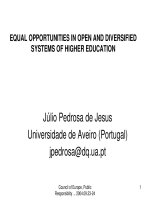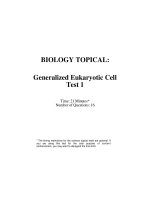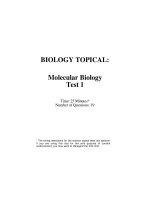6Respiratory and skins systems test w solutions
Bạn đang xem bản rút gọn của tài liệu. Xem và tải ngay bản đầy đủ của tài liệu tại đây (41.24 KB, 12 trang )
BIOLOGY TOPICAL:
Respiratory and Skin Systems
Test 1
Time: 21 Minutes*
Number of Questions: 16
* The timing restrictions for the science topical tests are optional.
If you are using this test for the sole purpose of content
reinforcement, you may want to disregard the time limit.
MCAT
DIRECTIONS: Most of the questions in the following
test are organized into groups, with a descriptive
passage preceding each group of questions. Study
the passage, then select the single best answer to
each question in the group. Some of the questions
are not based on a descriptive passage; you must
also select the best answer to these questions. If you
are unsure of the best answer, eliminate the choices
that you know are incorrect, then select an answer
from the choices that remain. Indicate your selection
by blackening the corresponding circle on your answer
sheet. A periodic table is provided below for your use
with the questions.
PERIODIC TABLE OF THE ELEMENTS
1
H
1.0
2
He
4.0
3
Li
6.9
4
Be
9.0
5
B
10.8
6
C
12.0
7
N
14.0
8
O
16.0
9
F
19.0
10
Ne
20.2
11
Na
23.0
12
Mg
24.3
13
Al
27.0
14
Si
28.1
15
P
31.0
16
S
32.1
17
Cl
35.5
18
Ar
39.9
19
K
39.1
20
Ca
40.1
21
Sc
45.0
22
Ti
47.9
23
V
50.9
24
Cr
52.0
25
Mn
54.9
26
Fe
55.8
27
Co
58.9
28
Ni
58.7
29
Cu
63.5
30
Zn
65.4
31
Ga
69.7
32
Ge
72.6
33
As
74.9
34
Se
79.0
35
Br
79.9
36
Kr
83.8
37
Rb
85.5
38
Sr
87.6
39
Y
88.9
40
Zr
91.2
41
Nb
92.9
42
Mo
95.9
43
Tc
(98)
44
Ru
101.1
45
Rh
102.9
46
Pd
106.4
47
Ag
107.9
48
Cd
112.4
49
In
114.8
50
Sn
118.7
51
Sb
121.8
52
Te
127.6
53
I
126.9
54
Xe
131.3
55
Cs
132.9
56
Ba
137.3
57
La *
138.9
72
Hf
178.5
73
Ta
180.9
74
W
183.9
75
Re
186.2
76
Os
190.2
77
Ir
192.2
78
Pt
195.1
79
Au
197.0
80
Hg
200.6
81
Tl
204.4
82
Pb
207.2
83
Bi
209.0
84
Po
(209)
85
At
(210)
86
Rn
(222)
87
Fr
(223)
88
Ra
226.0
89
Ac †
227.0
104
Unq
(261)
105
Unp
(262)
106
Unh
(263)
107
Uns
(262)
108
Uno
(265)
109
Une
(267)
*
58
Ce
140.1
59
Pr
140.9
60
Nd
144.2
61
Pm
(145)
62
Sm
150.4
63
Eu
152.0
64
Gd
157.3
65
Tb
158.9
66
Dy
162.5
67
Ho
164.9
68
Er
167.3
69
Tm
168.9
70
Yb
173.0
71
Lu
175.0
†
90
Th
232.0
91
Pa
(231)
92
U
238.0
93
Np
(237)
94
Pu
(244)
95
Am
(243)
96
Cm
(247)
97
Bk
(247)
98
Cf
(251)
99
Es
(252)
100
Fm
(257)
101
Md
(258)
102
No
(259)
103
Lr
(260)
GO ON TO THE NEXT PAGE.
2
as developed by
Respiratory and Skin Systems Test 1
Passage I (Questions 1–5)
All birds and mammals are able to maintain
relatively constant body temperatures despite fluctuations
in external temperature. These animals have evolved
thermoregulatory mechanisms that help them adapt to
their environments. One such mechanism involves
metabolic rates. A plot of the rate of oxygen consumption
versus body weight for various mammals reveals that
metabolic rate is inversely proportional to body weight
(Figure 1). However, metabolic rate and the transfer of
heat to the environment are directly proportional to the
surface area-to-volume ratio of the animal. For instance, a
shrew has a higher metabolic rate and a greater surface
area-to-volume ratio than a horse, which means that the
shrew generates more internal heat per gram of body
weight and loses more heat to the environment. This
makes it especially difficult for small animals to maintain
a constant body temperature in cold weather.
A thermoregulatory mechanism often used by
mammals to lose excess body heat in hot weather is
sweating, but this requires a large supply of readily
available water. Mammals inhabiting environments that
are both hot and dry have had to evolve alternative means
of handling the heat generated by metabolism. For
example, gazelles possess retia, vascular structures that
enable them to maintain organ-specific temperatures.
Gazelles have been found to have brain temperatures as
much as 2.9°C lower than their body core temperatures.
The existence of a vascular structure that thermally
isolates the head from the rest of the animal means that
scarce water is used only to cool the head, while body
temperature is allowed to rise. Local cooling of the head
occurs via panting.
Relative metabolic rate
Harvest mouse
Cactus mouse
House mouse
Flying squirrel
Rabbit
Rat Cat Human
Dog
Horse
0.01
0.1
A . Huddling increases the effective surface area-tovolume ratio, thereby decreasing the loss of body
heat.
B . Huddling decreases the effective surface area-tovolume ratio, thereby decreasing the loss of body
heat.
C . Huddling decreases the effective surface area-tovolume ratio, thereby increasing the loss of body
heat.
D . Huddling increases the effective surface area-tovolume ratio, thereby increasing the loss of body
heat.
2 . Based on the information in the passage, it can be
reasonably inferred that:
A . gazelles have evolved beyond the need for
thermoregulation.
B . the primary object of thermoregulation in
gazelles is the maintenance of a constant brain
temperature.
C . gazelles have not successfully adapted to their
environment.
D . gazelles tolerate large water losses.
3 . Which of the following is most likely true of an
animal that must keep all of its vital organs at
approximately the same temperature?
Shrew
0
1 . It has often been observed that small animals, such
as baby penguins, huddle together when it is cold
outside. What is the most likely explanation for this
phenomenon?
1
10
A . It could not survive in a desert environment.
B . It sweats excessively and becomes dehydrated in
hot weather.
C . Its body temperature is dictated by the most
temperature-sensitive organ.
D . It must always have a large supply of water.
100 1,000
Body weight (kilograms)
Figure 1
GO ON TO THE NEXT PAGE.
KAPLAN
3
MCAT
4 . The main advantage that the gazelle has over
mammals (inhabiting the same environment) that
cool themselves primarily by sweating is:
A . the ability to maintain a lower brain temperature.
B . the ability to tolerate higher external
temperatures.
C . lower metabolic requirements.
D . more efficient water conservation.
5 . Many Arctic animals have a countercurrent heat
exchange mechanism in their extremities that
prevents excessive heat loss from dissipation. Veins
returning from the extremities with cold venous blood
are in direct contact with arteries carrying warm blood
to the extremities. By which of the following
mechanisms is heat transferred from the arteries to the
veins?
A.
B.
C.
D.
Conduction
Convection
Radiation
Evaporation
GO ON TO THE NEXT PAGE.
4
as developed by
Respiratory and Skin Systems Test 1
Passage II (Questions 6–11)
Emphysema is a lung disease characterized by
marked destruction of the alveolar walls, leading to the
permanent enlargement of the alveoli. The condition arises
most commonly as a consequence of heavy cigarette
smoking. Smoking irritates the bronchi and bronchioles,
resulting in chronic infection. Furthermore, it causes
partial paralysis of the cilia of the epithelial lining of the
respiratory tract, disabling the mechanism for mucus
removal from the passageways. Finally, it stimulates
mucus secretion and inhibits the alveolar macrophages.
The resulting infection and excess mucus, along with
inflammatory edema (accumulation of fluid in the
epithelial tissue), lead to obstruction of many of the
smaller airways, making it difficult for the patient to
move air out of the lungs. The subsequent entrapment of
air stretches the alveoli and contributes to the destruction
of the alveolar walls.
Expiration becomes difficult in emphysematous
patients because bronchiolar obstruction increases airway
resistance. This resistance is already elevated during
expiration due to the compressive force on the outside of
the lung. Slowing of forced expiration is the most reliable
indicator of chronic emphysema.
The significant loss of functional lung tissue that
often results from chronic emphysema has two important
physiological effects. First, it causes a decrease in the
diffusion capacity of the lung, which is the ability of the
respiratory membrane to exchange gases between the
alveoli and the pulmonary capillaries. Second, it decreases
the number of pulmonary capillaries through which blood
can pass. As a result, the pulmonary vascular resistance
increases markedly, causing pulmonary hypertension.
7 . Oxygen moves from the alveoli into the pulmonary
capillaries and carbon dioxide moves from the
pulmonary capillaries into the alveoli via:
A.
B.
C.
D.
active transport.
facilitated diffusion.
simple diffusion.
osmosis.
8 . The decrease in the number of pulmonary capillaries
due to the loss of functional lung tissue will most
likely cause a pressure overload in the:
A.
B.
C.
D.
right atrium.
right ventricle.
left atrium.
left ventricle.
9 . A clinical test for emphysema is the forced
expiratory vital capacity maneuver, in which the
person first inspires to total lung capacity and then
expires as rapidly as possible. Which of the following
graphs best illustrates the difference in test results
between a normal individual and one with
emphysema?
normal
emphysema
A.
C.
lung
volume
lung
volume
seconds
seconds
6 . The inhibitory effect of cigarette smoking on the
alveolar macrophages will most directly contribute to
which of the following?
A . Increase in bacteria and solid particles in the
alveoli
B . Increase in the number of paralyzed cilia
C . Decrease in the destruction of alveolar walls
D . Decrease in the amount of functional lung tissue
B.
D.
lung
volume
lung
volume
seconds
seconds
GO ON TO THE NEXT PAGE.
KAPLAN
5
MCAT
1 0 . Based on the information in the passage a patient
with severe emphysema who is breathing at a normal
rate will exhibit:
A.
B.
C.
D.
low PCO2 and high PO2 in the blood.
low PCO2 and low PO2 in the blood.
high PCO2 and high PO2 in the blood.
high PCO2 and low PO2 in the blood.
1 1 . In an individual with emphysema, new, larger
alveolar chambers are formed as the walls of the
original alveoli dissolve and the alveoli coalesce.
However, the diffusing capacity of the lung is greatly
reduced. What best accounts for this phenomenon?
A . The total volume of the alveolar chambers is
decreased.
B . The total surface area of the respiratory
membrane is decreased.
C . The total number of alveolar chambers available
during respiration is decreased.
D . The thickness of the respiratory membrane is
increased.
GO ON TO THE NEXT PAGE.
6
as developed by
Respiratory and Skin Systems Test 1
1 4 . When an animal pants, it breathes rapidly in and out,
causing large quantities of new air to come into
contact with the upper portions of the respiratory
passages. The function of this mechanism is to:
Questions 12 through 16 are
NOT based on a descriptive
passage.
1 2 . Air entering the lungs of a tracheotomy patient
through a tracheostomy (a tube inserted directly into
the trachea) is colder and dryer than normal, which
often causes lung crusting and infection. This occurs
primarily because the air:
A . enters the respiratory system too rapidly to be
filtered.
B . is not properly humidified by the larynx.
C . does not flow through the nasal passageways.
D . does not flow past the mouth and tongue.
1 3 . The graph below shows the relationship between O2
consumption and total alveolar ventilation (the rate at
which air reaches the alveoli) during exercise. What is
the net effect of exercise on arterial PO2?
rapidly increase CO2 expiration.
moisten the mucosa of the respiratory passages.
minimize the movement of respiratory muscles.
decrease body heat via evaporation.
1 5 . Heat conduction to the skin is controlled by the
degree of vasoconstriction of the arterioles that supply
blood to the skin. Which of the following controls
the vasoconstriction of these arterioles?
A.
B.
C.
D.
Autonomic nervous system
Sensory nervous system
Somatic nervous system
Spinal cord
1 6 . A person unacclimatized to hot weather will often
lose as much as 15 – 30 g of salt each day for the
first few days due to profuse sweating. After 4 to 6
weeks of acclimatization, however, the same person
will lose only 3 – 5 g of salt per day. This decrease in
salt loss is caused by:
110
100
Total
alveolar
ventilation
(L/min)
A.
B.
C.
D.
80
60
A.
B.
C.
D.
40
20
1.0
2.0
3.0
increased ADH secretion.
decreased ADH secretion.
increased aldosterone secretion.
decreased aldosterone secretion.
4.0
O2 consumption (L/min)
END OF TEST
A . P O 2 remains the same, because ventilation
increases as metabolism increases.
B . P O 2 increases markedly, because ventilation
increases as metabolism decreases.
C . P O 2 decreases, because oxygen consumption
increases.
D . P O 2 initially decreases and then rebounds,
because ventilation increases.
KAPLAN
7
MCAT
ANSWER KEY:
1.
B
6.
2.
B
7.
3.
C
8.
4.
D
9.
5.
A
10.
8
A
C
B
A
D
11.
12.
13.
14.
15.
B
C
A
D
A
16.
C
as developed by
Respiratory and Skin Systems Test 1
RESPIRATORY AND SKIN SYSTEMS TEST 1 TRANSCRIPT
Passage I (Questions 1-5)
1.
Choice B is the correct answer. An animal's primary "goal" when it's cold outside is to keep warm. It wants
to limit the amount of heat lost to the environment, because the more heat it loses, the colder the animal feels. Realizing
that, you should have eliminated choices C and D immediately, since the last part of both statements says, "thereby
increasing the loss of body heat." So now you've narrowed it down to either choice A or B. The amount of heat transferred
from a body to its external environment is directly proportional to the amount of surface area (a.k.a. skin) exposed to the
external environment. If you couldn't recall this, the information was provided for you in the passage. If heat is lost through
exposed surface area, then it follows that the more surface area exposed, the greater the amount of heat lost. According to the
passage, smaller animals have a tougher time than larger ones trying to maintain a constant internal body temperature,
because smaller animals have a greater surface area-to-volume ratio and a higher metabolic rate than large ones. Therefore,
smaller animals generate more heat and lose more heat to their environment.
When the external temperature is lower than the animal's internal temperature, heat is transferred to the external
environment via radiation. Radiation is defined as the transfer of heat between objects that are not in direct contact. So, as I
already said, it follows that the more surface area exposed, the more heat lost. This means that if a group of small animals can
somehow decrease their collective surface area-to-volume ration, then they will lose less heat as a unit. Huddling
accomplishes this--when a group of small animals huddle together in the cold, they are decreasing the total surface area
exposed, as a group, to the environment. In other words, huddling decreases the effective surface area-to-volume ration,
thereby decreasing the loss of body heat per individual baby penguin. So, choice A is wrong and the correct answer is
choice B.
2.
Choice B is the correct answer. It's apparent from the question stem that this is a reading comprehension-type
question, obviously dealing with gazelles, since that's the subject that all four answer choices deal with. According to the
passage, gazelles have evolved structures called retia, which are vascular structures that allow them to maintain organ-specific
temperatures. Thus, right off the bat, you should have eliminated choice A, because we know that the gazelle has evolved
specific adaptations for thermoregulation; it has not evolved beyond the need for thermoregulation--no animal has. The
gazelle's retia are located in the carotid arteries, which are located in the next region, and afford the gazelle the luxury of
having a brain temperature almost 3 degrees cooler than its body core temperature. This also means that the gazelle doesn't
lose valuable water trying to cool down its head, so water is conserved--which is a particularly useful adaptation in a hot, arid
climate. From this, it can reasonably be inferred from the passage that one of the primary objects of thermoregulation in
gazelles is the maintenance of a constant brain temperature. So, choice B is the right answer. According to the passage, the
gazelle's head is cooled by panting, which involves rapid, short, shallow breaths that allow air to pass over the tongue and
evaporate saliva. Unlike sweating, panting does not incur a great loss of water, salt, and other essential ions. So choice D is
wrong. And this also makes it clear that choice C is not a valid conclusion, because the evolution of such complex and
unique thermoregulatory mechanisms implies that the gazelle has successfully adapted to its desert-like environment. Again,
choice B is the right answer.
3.
Choice C is the correct answer. You're being asked to draw a conclusion about what it means for all organs,
including the brain, to have a single body temperature. In the passage you're told that gazelles evolved retia to deal with a
climate that is both hot and dry. Water loss is kept at a minimum by only cooling the head, while body temperature is
allowed to rise. This seems to imply that the gazelle brain is a temperature-sensitive organ that must be maintained at a
particular temperature for proper functioning, regardless of external temperature and the temperature of the rest of the body.
Now, if an animal must keep ALL of its vital organs at the same temperature, and if one particular organ, such as the brain,
is the most temperature-sensitive organ, then the animal is obligated to maintain its body temperature at the temperature
required by that organ. So choice C is the right answer. Let's look at the remaining choices. You don't know at what
temperature the most temperature-sensitive organ in this hypothetical animal must be maintained, so you can't conclude that
this animal can't survive in a desert, or that it will sweat very heavily in hot weather. So choice A and B can be ruled out. As
for choice D--all animals need water to survive, including humans. But whether or not the animal needs a large supply of
water depends on how efficient its thermoregulatory mechanisms are; for instance, camels don't need much water even though
they live in a hot, dry environment. Again, choice C is the correct answer.
4.
Choice D is the correct answer. This is another question about the gazelle, and it requires you to infer what
advantage the gazelles with their retia have over other mammals in the same or similar habitat--a hot dry environment.
According to the passage, the main advantage to retia is water conservation. An animal that sweats in hot weather begins to
do so when internal heat production rises. When the sweat evaporates, it cools the body, but at the expense of a great water
loss. Gazelles, on the other hand, cool themselves by panting, and by allowing their body temperature to rise, thereby
conserving water. So in a hot, dry environment, the gazelle will lose less water than mammals who cool themselves by
sweating. So, choice D is the correct answer. Animals that sweat do not necessarily have higher metabolic rates, higher brain
temperatures, or a lower tolerance to high environmental temperatures. There's not enough information in either the passage
KAPLAN
9
MCAT
or the question stem for you to conclude any of these things. Hence, choices A, B, and C are all incorrect. Again, choice D is
the right answer.
5.
Choice A is the correct answer. This is one of those questions that is peripherally related to the passage
topic, which is thermoregulation, but that can really be answered without reading the passage at all. To answer it you have to
rely entirely on your outside knowledge of the methods by which heat is transferred from one object or surface to another. So
let's discuss the answer choices one by one. Conduction, choice A, is the transfer of thermal energy, or heat, between the
molecules of two bodies that are in direct physical contact and differ in temperature. Heat is transferred from the warmer body
to the colder body. In the countercurrent heat exchange mechanism found in animals inhabiting cold environments, such as
the Arctic fox, the warm arteries are in direct physical contact with the cold veins, allowing for the transfer of heat from the
arteries to the veins. So choice A is the answer to this question. Choice B, convection, is the movement of air or water in
currents to or from the body's surface. For example, when a person sweats on a breezy day, the evaporation of the sweat
warms the air above the skin; when air is warmed, it rises, and new, colder air now comes into contact with the surface of the
skin. Radiation, choice C, refers to the transfer of energy between objects that are NOT in direct physical contact by way of
electromagnetic waves. All objects with temperatures above absolute zero produce radiation. Thermal radiation occurs when an
animal's body temperature is warmer or colder than air temperature. Heat is exchanged between the animal and the air as
electromagnetic waves. Choice D, evaporation, is the loss of heat from the surface of a liquid as liquid molecules evaporate
into gaseous molecules. Every gram of water that evaporates dissipates over 500 calories, thus cooling the surface from which
it evaporates. Again, the correct answer is choice A.
Passage II (Questions 6-11)
6.
The correct choice is A. The alveolar macrophages, which are present in the alveolar walls, engulf bacteria,
dead cells, and particles that become trapped in the alveoli. The alveolar macrophages are white blood cells that fight to
prevent infection and are, therefore an integral component of the lung's defense system. Since, according to the passage,
smoking inhibits the alveolar macrophages and prevents them from doing their job, the amount of bacteria and the number of
solid particles in the alveoli will increase, and so choice A is correct. Even if you weren't familiar with the role macrophages
play in the alveoli, you could have deduced the right answer. It can be inferred from the passage that inhibition of the alveolar
macrophages promotes infection. Among the choices, the only one that would lead directly to infection is choice A.
While it is true that smoking causes an increase in the number of paralyzed cilia of the lung epithelium (choice B)
and a decrease in the amount of functional lung tissue (choice D), these effects are not the direct consequence of the inhibition
of macrophages. Choice C makes no sense because smoking causes an increase, not a decrease, in the destruction of alveolar
walls. Again, choice A is the right answer.
7.
The correct answer is choice C. First, let's review each of the mechanisms of transport. Active transport,
choice A, is the net movement of dissolved particles against their concentration gradient with the help of carrier molecules.
Active transport requires energy in the form of ATP. An example of active transport is the sodium-potassium pump. You can
eliminate active transport right away because the passage refers to the "diffusion capacity" of the lung. Facilitated diffusion,
choice B, is the net movement of dissolved particles along their concentration gradient with the help of carrier molecules. It
does not require energy input. An example of facilitated diffusion is glucose transport in the nephron. Simple diffusion,
choice C, is the net movement of dissolved particles down their concentration gradient. Diffusion is a passive process. An
excellent example of simple diffusion is gas exchange in the lungs. Oxygen diffuses from the alveoli, where it is highly
concentrated, into the pulmonary capillaries, where there is a low concentration of oxygen, without the help of carrier
molecules; carbon dioxide diffuses from the pulmonary capillaries into the alveoli, down its concentration gradient. Thus
choice C is the correct answer. Choice D, osmosis, is the simple diffusion of water from a region of lower solute
concentration to a region of higher solute concentration--since we are obviously not talking about the movement of water in
this question, you can eliminate choice D right away as well. Again, choice C is the right answer.
8.
The correct answer is choice B. The right ventricle of the heart pumps deoxygenated blood into the lungs via
the pulmonary arteries. Remember, arteries carry blood away from the heart. When the loss of functional lung tissue reduces
the number of pulmonary capillaries through which blood can flow, the resulting pressure overload leads to right ventricular
enlargement, a condition known as cor pulmonale. The right atrium, choice A, pumps deoxygenated blood returning from the
body into the right ventricle. The left atrium, choice C, receives oxygenated blood from the lungs via the pulmonary veins,
and pumps the blood into the left ventricle, choice D. Again, choice B is the right answer.
9.
The correct answer is choice A. The passage stresses than an emphysematous patient has a great deal of
difficulty with expiration, or exhaling. In fact, we're told that "slowing of forced expiration is the most reliable indicator of
chronic emphysema." We can therefore predict that the graph of an emphysematous patient performing the forced expiratory
vital capacity maneuver will show lung volume declining more slowly over time during expiration than it would in a normal
individual, while inhalation is the same in both individuals. Choice A, graph A, is the graph that most accurately reflects
this, and is our right answer.
10
as developed by
Respiratory and Skin Systems Test 1
Graph B shows the emphysematous patient having difficulty both with inhalation and exhalation. Choice B can thus
be eliminated because the passage never says that patients with emphysema have difficulty with inhalation. According to
graph C, the emphysematous patient is able to exhale more rapidly than the normal individual, which is clearly not the case,
and so choice C is wrong. Graph D indicates that both inspiration and expiration are quicker in the emphysematous patient.
This is the exact opposite of what we would predict from the passage and so choice D is wrong. Again, choice A is the right
answer.
10.
The correct answer is choice D. According to the passage, an emphysematous patient's lungs have severely
reduced diffusing capacity. This means that oxygen won't diffuse into the pulmonary blood at the normal rate, nor will carbon
dioxide be able to diffuse out of the pulmonary blood at the normal rate. As a result, the blood of someone with severe
emphysema will exhibit high PCO2 and low PO2, which is choice D.
11.
The correct answer is choice B. The diffusing capacity of the lung depends on the respiratory membrane,
since this is the membrane across which the diffusion of gases occurs. If there is any loss of respiratory membrane--that is, if
the total surface area of the membrane is reduced by some sort of damage--the diffusing capacity of the lung will be reduced.
When the alveoli coalesce, or consolidate, as occurs with emphysema, the new alveolar chambers may be larger, but the total
surface area of the respiratory membrane is reduced, thus decreasing the diffusing capacity of the lung. So, choice B is the
right answer.
Choices A and C are wrong because neither the total volume of the alveolar chambers nor the total number of
alveolar chambers is directly relevant to diffusing capacity. Furthermore, the total volume of the alveolar chambers will most
likely be increased, not decreased, in the emphysematous patient--that's why these patients are often barrel chested. The
number of alveolar chambers will certainly decrease, not increase, as small alveoli coalesce into larger ones. As for choice D,
there is no evidence in the passage that the dissolution of alveolar walls has any impact on the thickness of the respiratory
membrane. Again, choice B is the right answer.
Discretes (Questions 12-16)
12.
Choice C is the correct answer. When a patient breathes through a tracheostomy, the air entering the
respiratory system bypasses a very important area: the nasal cavities. In a normal-breathing individual, the extensive surfaces
of the nasal passageways warm and almost completely humidify the air, and particles are filtered out by a nasal air turbulence
mechanism. Since the air reaching the lungs of a tracheotomy patient has not been warmed or humidified, lung crusting and
infection often result. The speed with which air enters the lungs, choice A, is not what prevents the air from being filtered
properly. The air does bypass the larynx (choice B) and the mouth and tongue (choice D) in a tracheotomy patient, but this is
irrelevant, since air is primarily warmed and humidified by the nasal passageways. So, choices A, B, and D are wrong, and
choice C is the right answer.
13.
Choice A is correct. The rate of alveolar ventilation is directly related to the partial pressure of O2 in the blood:
the greater the rate of ventilation, the more oxygen there will be in the alveoli to diffuse across the respiratory membrane into
the pulmonary capillaries. It makes sense that alveolar ventilation increases during exercise (when you breathe more deeply
and rapidly) because metabolism is accelerated and there is a greater need for oxygen. Judging from the graph, alveolar
ventilation increases almost exactly in step with increased metabolism (represented by O2 consumption). The increasing
supply of oxygen is in balance with the increasing demand for it, so you can infer that the partial pressure of O2 in the arteries
will be about the same as the rest. Thus, choice A is correct. Choice B is out because ventilation increases as metabolism
increases, not as it decreases. Choice C does not take into account the effect of increased alveolar ventilation, so it's wrong.
Choice D would only be true if alveolar ventilation did not increase step for step with metabolism. Again, choice A is the
right answer.
14.
Choice D is correct. Many animals do not have sweat glands, so sweating cannot be a means of evaporative
heat loss. The panting mechanism, which is described in the question stem, serves as a substitute or as a complement to
sweating. The large amounts of air that come into the upper respiratory passages permit water evaporation from the mucosal
surfaces, thereby allowing for heat loss. Panting is turned on by thermoregulatory centers of the brain that monitor blood
temperature. Thus, choice D is correct. Choice A is wrong because an animal's rapid breaths during panting are not deep
enough to have a significant impact on the rate of carbon dioxide expiration. Choice B is the opposite of what actually
happens, so it's wrong. Choice C is irrelevant; while your respiratory muscles do probably move faster during panting, this
movement does not serve a thermoregulatory function. Again, choice D is the right answer.
15.
Choice A is correct. This is a pure outside knowledge question. The autonomic nervous system regulates the
internal environment by controlling involuntary actions and processes. It innervates the heart, smooth muscle in blood
vessels and the digestive tract, and the endocrine, excretory, reproductive, and respiratory systems. The sympathetic division of
the autonomic nervous system controls the vasoconstriction of the arterioles in response to changes in temperature, so choice
A is the one you want. If you weren't sure about the answer right away, you could have eliminated the wrong answers. The
KAPLAN
11
MCAT
job of the sensory nervous system, choice B, is to convert stimuli into action potentials; it includes the eye and the ear, as
well as skin, taste, and olfactory receptors. The somatic nervous system, choice C, innervates skeletal muscles in response to
external stimuli. The spinal cord, choice D, integrates simple motor responses and relays information to and from the brain.
None of these is directly involved in the vasoconstriction of arterioles, and so choices B, C, and D are wrong. Again, choice
A is the right answer.
16.
Choice C is the right answer. Aldosterone, which is produced by the adrenal cortex, increases the rate of Na+
reabsorption by the kidney and sweat ducts. Aldosterone secretion is stimulated by a decrease in blood volume, such as the
decrease caused by profuse and prolonged sweating in hot weather. Increased aldosterone secretion after a few weeks of
acclimatization to hot weather would therefore significantly reduce the loss of salt, and so choice C is correct. Decreased
aldosterone secretion would increase the loss of salt, so choice D is incorrect. ADH (antidiuretic hormone), which is also
known as vasopressin, increases water reabsorption by acting on the kidney to increase its permeability to water. ADH
secretion is stimulated by a rise in plasma osmolarity. Neither an increase in ADH secretion nor a decrease in ADH secretion
would reduce the loss of salt, so choices A and B are wrong. Again, choice C is the right answer.
12
as developed by









